1. Are your students at the associates or baccalaureate level?
My two courses are freshmen and sophomore level classes and apply to both degrees.
2. Do you use different teaching strategies for associate level students than for baccalaureate level students? Why or why not?
I use the same teaching strategies for both degree levels because 1) I don’t know the pathway that the students are in 2) many of the students are unsure of the level they want to pursue
3. What is metacognition and what concept from the chapter resonates with you and why?
Metacognition is “the ability to think about one’s own thinking, be consciously aware of oneself as a problem solver, monitor, plan, and control one’s mental processing, and accurately judge one’s level of learning” (p. 17). For students to be aware of themselves as a problem solver, monitor, and planner is an imperative skill. Being self-aware of their learning, learning style allows them to become self-advocates. They can understand what tools they may need in order to become more successful students and can ask for help, permitting more personal control, responsibility and confidence in their learning process.
4. What are other factors that might influence student learning?
Other factors that influence student learning can be their socio-economic status, family obligations, race and culture, gender, and previous exposure to the subject matter.
5. How can metacognition help us towards our goal of increasing retention 5-10% starting in the fall?
It’s important that students become aware of what type of learning and teaching best suits them. We can provide our students with additional resources to best cater to those learning styles. Also, students who understand that we want them to succeed will also feel more supported in our classrooms.



